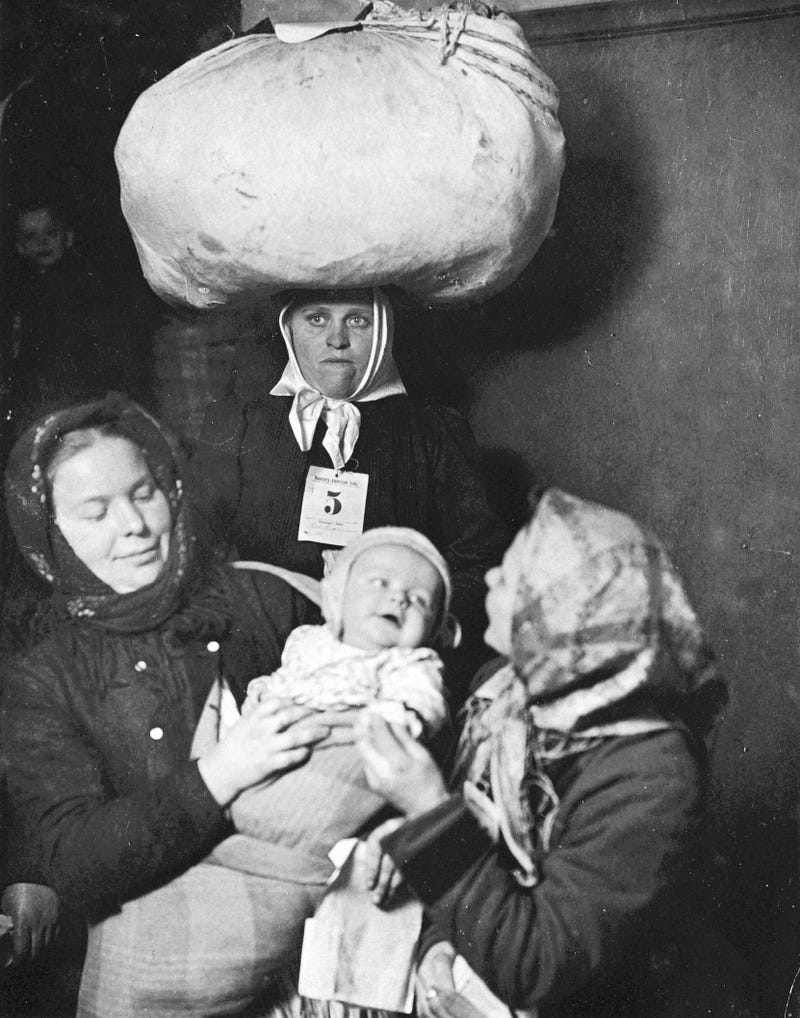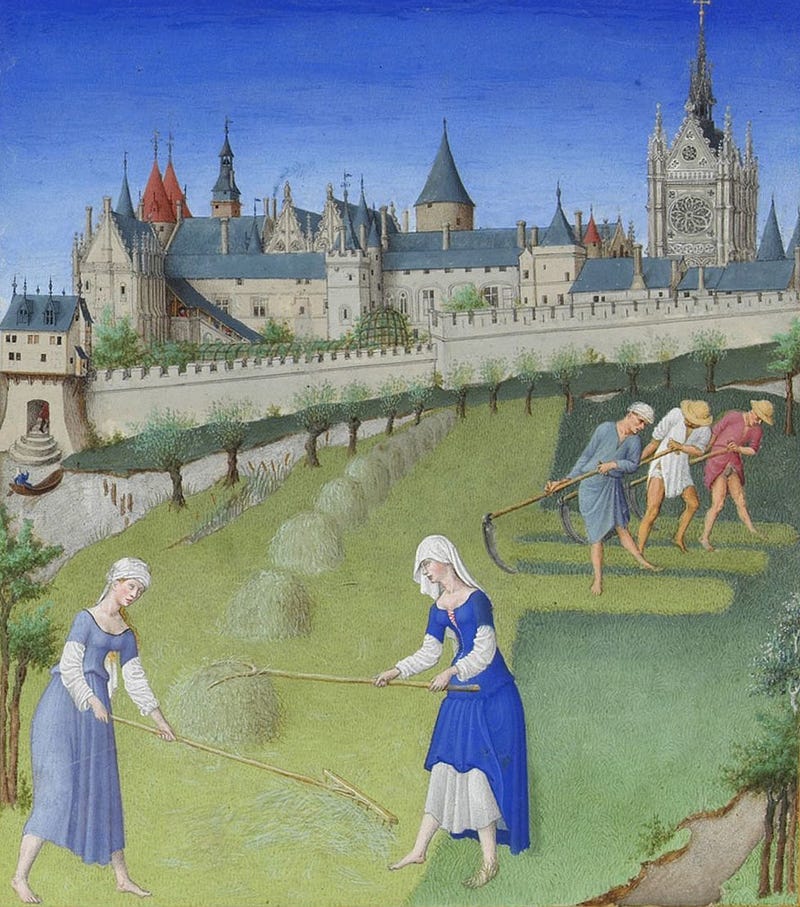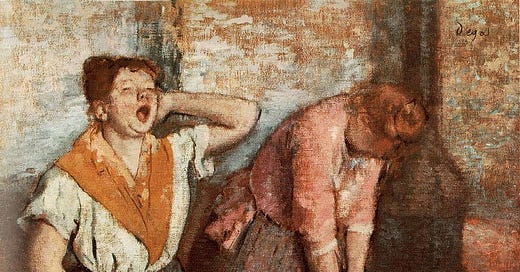Women Have Always Done Society’s Heavy Lifting — Literally
Although we’ve long ignored their back-breaking labour, and, unfortunately, still do today

The Noösphere is an entirely reader-supported publication that brings social sciences research into frequently overlooked topics. If you read it every week and value the labour that goes into it, consider liking or sharing this essay or becoming a paid subscriber! You can also buy me a coffee instead.
Once upon a time, a woman’s greatest struggle was mustering the energy to rise from her cosy sofa and whip up a hearty meal before her husband returned from a long day spent tirelessly building the world we live in now.
Well, no — not really. That fantasy might be role-played today by women advocating for a return to ‘traditional’ gender norms and ‘soft, feminine lives’ — often while building decidedly less ‘trad-like’ brands and businesses around the lifestyle — but it’s about as historically accurate as the idea that cave dwellers spent their downtime making Instagram Reels.
But even those with less extreme views tend to embrace a version of this narrative: that men, through centuries of strenuous toil, laid the foundations for the society we now enjoy, and we should all be glad for their sacrifices. Where would we, meek female creatures, even be without them? Exactly. Nowhere in particular. This belief that men built the entire world on their backs is also a close relative of the claim that women are ‘the weaker sex.’ After all, both women’s supposed (and inherent) uselessness and helplessness have long been used to justify their secondary status in society, reducing female worth almost entirely to reproductive capacity.
Only that’s not what past — and current — records show. The truth is, we just haven’t bothered to consider the full scope of women’s labour before.
In many rural parts of the world — particularly across Africa, but also regions of Asia, Latin America, and Europe — there’s a practice known as ‘head-loading’ or ‘head-carrying.’ It’s a method of transporting essentials like food, water, firewood, tools, and even children , not slung over the back or shoulders, but carefully balanced on the head. And it’s been primarily women who’ve done it, often carrying loads equivalent to up to 70% of their body mass, or even heavier than their own weight, over long distances and across challenging terrain.

Yet, despite its widespread use, head-loading remains largely absent from mainstream historical narratives about labour and gender roles. A recent study published in the Journal of Anthropological Archaeology revealed, however, that women in Nubia (present-day Sudan) were frequently practising head-loading as far back as 3,500 years ago, during the Bronze Age, and that it was so physically demanding it literally reshaped their anatomy. While male skeletons at the burial site examined (Abu Fatima) showed wear and tear on one shoulder and related joints — suggesting they carried heavy loads on one side — female skeletons exhibited significant strain in the upper spine, indicating the repeated use of muscles involved in bearing weight on the head.
The paper also notes that cross-cultural ethnographic records show this practice was common in other parts of the ancient world, including among Indigenous tribes in North America, Mesoamerican civilisations, and communities in Eastern and Central Africa.
As Jared Carballo, lead author of the study, put it:
This way of life is as common as it is overlooked by written history. In some way, the study reveals how women literally have carried the weight of society on their heads for millennia.
Still, while research into prehistoric women’s contributions remains relatively scarce, it continues to grow and continues to challenge the assumption that physical labour was always the exclusive domain of men. Another study, published in Science Advances in 2017, analysed the skeletons of Central European women who lived around 7,000 years ago — at the beginning of the Neolithic period and the Agricultural Revolution — and found that their upper body strength ‘exceeded that of living athletes.’ This means that women frequently engaged in intense, repetitive upper-body work, likely related to food production and processing. Earlier evidence from the Palaeolithic era similarly shows little support for the notion that labour was strictly divided along sex lines, with archaeological findings pointing instead to more fluid and shared responsibilities between men and women.
Even as we move closer to the more recent past, countless women continued to perform physical labour. Take the construction field, for instance, long considered a no-go zone for them. But as architectural historians Yilmaz Hatipkarasulu and Shelley Roff note in their research:
Historically, single and poor married women worked as low-paid day labourers on construction sites performing unskilled tasks such as carrying water, digging ditches for foundation walls, thatching roofs, and mixing mortar. (…) Numerous city records provide examples of women working with their fathers and husbands in the building trades as masons, carpenters, doormakers, and others crafts in 13th, 14th, and 15th centuries France, Spain and Germany.
Records from Spain even point to women working as cathedral builders, while English sources include many examples of farms managed solely by widowed or unmarried women. Later records also show that women were a substantial portion of the industrial workforce, particularly in textile factories.
Still, we also do know that women were limited in what they could do, especially when it came to skilled labour. And even when they secured work, they were often left off official records (even much later on, women working in agriculture, construction, or other family businesses were still listed in censuses simply as ‘wife’) and typically earned only half to three-quarters of what men did. Impoverished and enslaved women weren’t paid at all, though, and they usually performed the same physically demanding, back-breaking labour as men. In some cases, like rice cultivation in the American South, for example, enslaved African American women even made up the majority of fieldworkers. If anything, you could argue they laboured more than their male counterparts, as they were also expected to create the next generation of labourers — and have to do so in gruesome, inhumane conditions.
But even work more typically associated with women doesn’t get the recognition it deserves either.
It’s not just that women’s contributions to our world have been largely ignored, swept away by the tide of patriarchal fairy tales; it’s also that what counts as valuable, productive work tends to exclude the kinds of activities women have frequently done. What we label ‘women’s work’ is viewed through a rather distorted lens: if a woman does it, it must be easy. Or — it must just come naturally to us, somehow. As a result, this labour is assumed to require less strength, resilience, and skill than men’s. But in reality, there’s nothing easy or less essential about it.
Beyond their involvement in more ‘masculine’ fields, women also played major roles in vital cottage industries that similarly remain under-discussed in historical contexts as they were embedded within the domestic economy and often went unrecorded. This included work in textiles, apparel, tapestry, dairy, brewing, baking, food preparation, and distribution — all of which demanded a good dose of strength, stamina, and know-how, much of it passed down orally from one generation of women to the next. Even the tools women mastered — like spindles and rudimentary looms for textile production — weren’t seen as ‘proper’ technologies, and only gained that status once men took over these fields during the Industrial Era.
On top of everything else, women worked alongside men in the fields, particularly during harvest, tended livestock, managed farms, and kept their homes. And, in the midst of all that, they gave birth.

Today, the labour that sustains households and communities — both paid and unpaid — is still widely dismissed as something that doesn’t require much strength, time, or skill. But it does.
Globally, women and girls perform around 75% of all unpaid domestic and care work, which includes, apart from the obvious tasks like cooking and cleaning, collecting and carrying water, fuel, and food, subsistence farming, and caring for the sick and the elderly. In rural transportation surveys conducted in African countries like Ghana, Tanzania, and Zambia, women were found to carry four times the volume and spend three times as much time on transport activities as men. This literal heavy lifting, done mostly by women, keeps daily life running — yet it remains undervalued and largely invisible.
In some regions, women also work as porters, carrying heavy loads on their heads for 8 to 10 hours a day. And while men sometimes engage in porterage too, they’re at least usually paid higher wages for this work.
Even when it comes to female-dominated fields in the West, their physical and mental demands are frequently underestimated. It’s often assumed, for example, that only men do jobs that cause serious injury or death. But recent analysis by The Washington Post, using US Bureau of Labor Statistics data, found that the occupational groups with the highest rates of severe non-fatal injuries are all dominated by women: psychiatric aids and technicians, registered nurses, personal care workers, elementary teachers, and teaching assistants. Many of these jobs also have some of the highest burnout rates. In nursing, for instance — a field still overwhelmingly female — the burnout rate is currently around 65%.
Women are also increasingly entering physically demanding, traditionally male-dominated fields. But when they do, they don’t just face the standard risks of the job, but also higher rates of sexual harassment, gender discrimination, and more frequent injuries as tools and protective equipment are still designed primarily for the average male body.
Clearly, women have always contributed — and continue to contribute — to building and sustaining our world. What’s lacking isn’t their effort, but our recognition of it. And that absence of recognition still carries serious consequences today.
Whenever I come across the claim that women should be ‘grateful’ that men always took on all the ‘dirty work,’ I often think of the women in my own family. On my mother’s side, my female ancestors lived in rural Silesia and worked in agriculture and construction alongside men. The few pictures I’ve seen of my great-grandmother, Katarzyna — whom I was named after — don’t exactly show a dainty little creature who spent her days dilly-dallying around the house. She was tall and broad-shouldered, with big hands, thick arms, and a long braid of raven-dark hair she wore until she passed away at nearly 100 years old. Personally, I can’t imagine a more badass woman.
Most people, I suspect, have women like this in their family trees, too. Women who ploughed fields, hauled heavy loads, laboured in factories, trades and domestic service, and then also kept their own households running. They didn’t just endure — they carried entire lives, families, and communities on their backs.
A woman can carry more in her apron than a man can carry on nine horses.
And yet, though we expect women to do society’s heavy lifting — literally and figuratively — we then turn around and gaslight them about having any strength. Or any ‘real’ contribution. Women are praised for their resilience but dismissed when they try to assert it; entrusted with holding everything together, yet overlooked when credit is handed out. It’s a contradiction rooted in patriarchal myths, but also all the norms we continue to think of as ‘tradition.’
However, what people really talk about when they talk about ‘traditional’ femininity and ‘traditional’ gender roles is a teeny-tiny slice of history — something around 0.1% of human timeline, if we’re being generous — experienced by a teeny-tiny fraction of the female population — mostly just white, middle- or upper-class women in industrialised nations.
The rest of the women worked, just as they always have, despite what androcentric retellings of history would have us believe.
Now, none of this is to say that men didn’t do hard work as well. Both women and men built our world, and many paid for it with their health, their bodies, and sometimes their lives. But because we rarely consider this full picture, we continue to undervalue women’s work — and women themselves. That’s true across the board: from domestic and care work (largely ignored by mainstream economics and politics), to female-dominated professions (which tend to pay less than male-dominated ones), to male-dominated fields (where women often face glass ceilings and other barriers). All of this then also leads to issues like unequal burdens of unpaid work for women, persistent gender pay gaps, and the low participation of men in vital professions like education, nursing, and care.
It’s time we started valuing all labour and all working people, regardless of gender, and stopped pretending that any job is ‘unskilled’ or ‘easy,’ labels only used to justify underpaying those who do them.
And then, ideally, dismantle the idea that it’s normal to have to work ourselves to death just to (barely) survive. Intense, back-breaking labour and exploitation may have defined the past few centuries, but this period hardly represents what’s been typical for most human history.
Women have always worked — hell, they often didn’t have much of a choice. Neither did men. They did what they had to do to survive. And many still do today, all around the world.
Still, while our history deserves recognition, not romantic or patriarchal revision, our future demands we reconsider whether survival or progress always need to come at such a high cost.
And if we ever hope to create something better, we must also move beyond the contradiction that asks half the population to carry the load while simultaneously pretending it mostly doesn’t exist. It very much does.




Mary Collier’s poem The Woman’s Labour (1739) rebutted Stephen Duck’s attempt to trivialise women’s participation in labour (The Thresher’s Labour, 1730). Mary’s was an epic take-down-hilarious and spot-on. Mary herself was a labourer who worked as a washing woman as well as working in the fields during harvest. She never married, paid ro have her poems published, and eventually owned her own mill. She lived a long life (not bearing children was one factor, since pregnancy and delivery resulted in high maternity rates).
I'm glad you didn't give up on this article and shared it now. Our family's ancestors are proof of this heavy labor by women, and I've witnessed it in other countries as I've studied there. When will we see the wide variety of labor and value each?